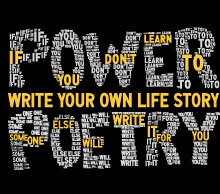
If you’ve seen spoken word poetry videos floating around Facebook and YouTube—but weren’t sure what they were all about—check out this intro to slam poetry. Find out what makes slam poems unique and why they’re so much fun to watch when performed live.
Slam poetry is a spoken-word form of poetry that is largely influenced by the free verse, musical style of Beat poets like Jack Kerouac and Allen Ginsberg. It first took hold in the U.S. in the 1980’s, when open mic sessions started taking place at cafés in cities like New York, San Francisco, and Austin.
Who started it? Some point to Marc Kelly Smith, a Chicago poet who is also known as “Slampapi.” He believed that academic poetry was too structured and stuffy, and wanted to introduce a looser poetry medium. He founded the first-ever National Poetry Slam in 1990 and that annual competition still goes on today.
Another driving force that made slam poetry popular was the HBO television show Russell Simmons Presents Def Poetry, which ran from 2002 to 2007 and spawned a Broadway show and a book.
Below, find out what makes a slam poem different from other types of poems.
- Slam poems are meant to be performed. Words in slam poems are chosen for their meaning but also for the way they sound when read aloud. Rhyme schemes and rhythms can be utilized if a poet chooses, and those devices can give some slam poems a hip-hop feel. But there is no formal structure and there are no rules—any style is welcome and that freedom is what many slam poets find inspiring. Slam poets commonly use dynamics (going from a whisper to a shout), pacing (speeding up and slowing down) and pausing to add drama.
- The topics tend to be political. You’ll often find slam poets talking about bold, heavy issues, such as race, gender, class, sexuality, discrimination, war, religion and more.
- Slam poems are meant to provoke. Slam poetry is designed to trigger emotional responses from a live audience. In most poetry slams, a winner is chosen at the end, so in order to gain a competitive edge over other contestants, poets strive to elicit cheers, laughs, or gasps, depending on the topic.
- A little acting is welcome. No props or costumes are allowed, but bodily movements and facial expressions are fair game and can add depth and meaning to a performance. For example, watch slam poet Alex Dang during his performance of "What Kind of Asian Are You?" as he uses various hand motions to illustrate what he's saying and drive home his message.
Get more advice for writing your own slam poem by checking out 5 Tips for Slam Poetry and Slam Poetry and Spoken Word Resources on PowerPoetry.org!
Image via the Oakland Local
